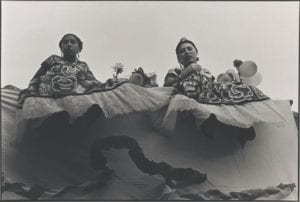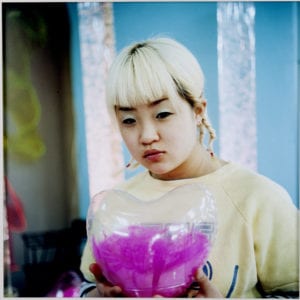February 21, 2020 | By Victoria Jorgensen
Through May 24
Tampa Museum of Art
Details here

Quick, name ten female photographers from any century… five? One?
Unless you were an art or history major, chances are you may be coming up blank. If you came up with a few, you may have named Diane Arbus, Dorothea Lange, Barbara Krueger or even Cindy Sherman. Their work is included in this show, but by no means solely defines it.
The Tampa Museum of Art is celebrating their 100th Anniversary with over one hundred photographic works of women photographers who shaped the genre and the world.
Bank of America has amassed the most stunning collection of works in North America and is sharing images with installations across the country through their Art In Our Communities® program. This is one of three installations this year curated by host museums including TMA. The exhibit premiered in Napa Valley prior to Tampa and will move on to Sacramento when the show closes here on May 24.
Modern Women: Modern Vision includes 100+ photographic works representing over 100 years of creative women who changed the cultural landscape around the world. The pieces are curated in six distinct sections:
Modern Innovators
Including: Eve Besnyö, Margaret Bourke-White, Imogen Cunningham, Gertrude Käsebier and Barbara Morgan

At the beginning of the 20th Century, photography provided women with creative and financial independence.
At first, photography mirrored traditional painting using soft focus and painterly effects but as the mid-‘20s rolled in, a new generation of photographers relied on this breaking technology to render people, places and things with fresh perspectives, unusual camera angles and methodical elements like shape, texture and value.
Documentary Photography and the New Deal
Including: Bernice Abbott, Margaret Bourke-White, Dorothea Lange and Marion Post-Wolcott
Women were in the vanguard, positioning photography at the forefront between the World Wars. Social documentary and photojournalism became tenable art forms and professions.
President Franklin D. Roosevelt hired a plethora of women to document Americans devastated by the Great Depression and the Dust Bowl. His administration utilized their photographs to garner support for his New Deal programs under the Farm Security Administration (FSA) project. Women artists were also provided financial support through the Federal Art Project (FAP) which focused on American progress and technological advancements.

The camera was ideal for documenting American life. Newspapers, magazines and books provided an objective vehicle to record the details of current life and generated sensitivity which led to political change.
The Photo League
Including: Esther Bubley, Sonia Handelman-Meyer, Rebecca Lepkoff, Helen Levitt and Ruth Orkin
American women were denied access to many “camera clubs” in the mid-20th century. But New York’s Photo League membership included over 30% women, many of whom helmed positions of leadership.
The Photo League was crucial to the advancement of documentary and street photography. The membership was diverse, including young, first-generation Americans with a progressive political point of view. Their work sistered the rural life documentation of FSA photographers but with an urban lens.
“The city” became the subject and 35mm cameras allowed artists to capture images more quickly without being noticed. Skillful framing allowed the viewer to be more emotionally present in the frame. Many of the Photo League members were commissioned by glossy slick magazines like Look and Life.
Modern Masters
Including: Diane Arbus, Graciela Iturbide, Barbara Kruger, Lisette Model and Cindy Sherman

Photography continued growing after World War II, but became more personal. Photographers transformed the mundane aspects of everyday life through their subjective filters. Their interpretations of modern life were based on their own unique experiences.
Criticism of mass media’s social norms birthed a new viewpoint helped by the rise of feminism in the 1960s and ‘70s. Photographs became a way to defy gendered social norms and stereotypes.
The external became the internal, arguably the genesis of the selfie. Conceptualism and exploration of self identity shifted the process — source materials such as print, film and television now became part of the image inside the frame.
Exploring the Environment
Including: Virginia Beahan, Laura McPhee, Bernd and Hilla Becher, Marie Cosnidas, Lynn Davis, Terry Evans and Barbara Klemm
The late 19th century opened a whole new world for female photographers. Women burst out of their traditional, gender-based restraints and explored the world outside their homes.
Throughout the 20th century, women investigated environments affected and not affected by humans. They recorded images of the natural and the unnatural with their unique emotional point of view.
Some used direct, candid approaches inviting the viewer’s interpretation while others generated subjective, fictional, darkroom-manipulated content with a disconcerting effect.
Global Contemporary Lens
Including: Ana Casas Broda, Rineke Dijkstra, Candida Hofer, Karina Juárez, Michal Rovner, Tomoko Saweda, Hellen Van Meene, Carrie Weems and others.

Contemporary female photographers utilize the trailblazing techniques of those who came before them, but now take advantage of the almost limitless power of digital cameras and editing software to create what their muses provide.
Several of the artists in the show do not claim the “photographer” title, but employ still frames from video, create installations or make use of the ability to print in large format as ways to include the medium itself in their work.
Now, the boundaries between fact and fiction have all but disappeared. Photographers utilize choreography, costuming and narratives to create images that tell their stories. Photography is less about capturing what you see and more about creating what you want others to see.
When is the last time you posted a photo of something “ugly” on social media? If a stranger reviews your Facebook page, will they learn about you — or who you want them to see?
This exhibition will enrich your awareness of the progress women have made in the art of photography and the role they played in framing social, political and economic change in the modern world.
Find more artists at Women in Photography
Explore Women Photographers: 34 Voices from Around the World




